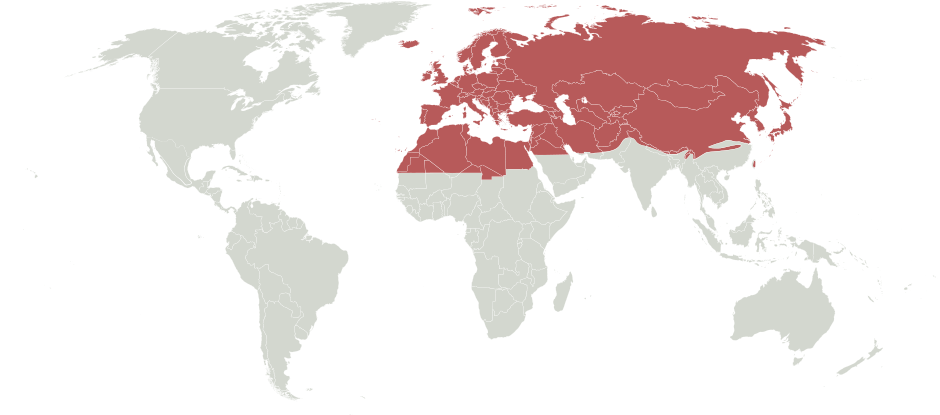Family: Megachilidae
Subfamily: Megachilinae
Tribe: Osmiini
Genus: Osmia Panzer, 1806
Subgenus: Neosmia Tkalců, 1974
Common name: none
Osmia (Neosmia) are robust, non-metallic bees with long, red, pale, black, or mixed hairs throughout their entire body. They range in body length from 7.5–15 mm (Michener 2007Michener 2007:
Michener, C.D. 2007. The Bees of the World (2nd ed.). Johns Hopkins University Press, Baltimore and London, 953 pp.).
(modified from Michener 2007Michener 2007:
Michener, C.D. 2007. The Bees of the World (2nd ed.). Johns Hopkins University Press, Baltimore and London, 953 pp.)
 . In the middle of the truncated margin, there is a small-depressed area.
. In the middle of the truncated margin, there is a small-depressed area. apicalapical:
apicalapical: is simple and without laterallateral:
is simple and without laterallateral: is bilobed.
is bilobed.Osmia (Neosmia) may be confused with O. (Tergosmia) because of the short first flagellar segment, but they can be differentiated by the presence of a hair-filled median emarginationemargination:
a notched or cut out place in an edge or margin, can be dramatic or simply a subtle inward departure from the general curve or line of the margin or structure being described
on S3S3:
the plates on the underside of the abdomen, often abbreviated when referring to a specific segment to S1, S2, S3, S4, S5, S6, S7, or S8
 , which is absent in O. (Tergosmia).
, which is absent in O. (Tergosmia).
Osmia (Neosmia) are generalists on a multitude of families including Fabaceae, Resedaceae, Brassicaceae, Cistaceae, Asteraceae, Boraginaceae, Lamiaceae, Zygophyllaceae, and Cichorioideae (Müller 2018b).
Osmia (Neosmia) construct their nests in empty snail shells. Osmia bicolor uses masticated leaf materials to line the cells of their nest. Additionally, O. bicolor creates a pile of pine needles and grass with a secretion to cover the snail shell (Westrich 1989Westrich 1989:
Westrich, P. 1989. Die Wildbienen Baden-Wuuml;rttembergs. Eugen Ulmer GmbH amp; Co., Stuttgart, 972 pp.). Nest plugs are constructed from pebbles and dirt (Müller 2018b). Osmia rufigastra constructs cell partitions out of masticated leaves. The nest plug is comprised of leaf pulp and densely packed particles, followed by a final wall of leaf pulp with fragments of shell. The surface of the snail shell is covered in leaf pulp, and the shell is transported and buried in a sandy location (Müller 2018b). Osmia cinnabarina builds cell partitions within the snail shell out of chewed leaves. The nest plug is comprised of leaf pulp and densely packed particles, followed by a final wall of leaf pulp with fragments of shell and small pebbles. The surface of the shell is covered with leaf pulp (Müller 2018b). Osmia scutispina does not bury the snail shell nest into the ground as seen in many other species (Müller 2018b).
Osmia (Neosmia) consists of nine species (Michener 2007Michener 2007:
Michener, C.D. 2007. The Bees of the World (2nd ed.). Johns Hopkins University Press, Baltimore and London, 953 pp.; Müller 2018b). None are known to occur in the U.S. or Canada.
There are no known invasives.
Osmia (Neosmia) is found in the PalearcticPalearctic:
the largest biogeographic region; consists of Europe, Asia north of the Himalaya foothills, Northern Africa, and the northern and central parts of the Arabian Peninsula (Müller 2018b).
(Müller 2018b).

Distribution map generated by Discover Life -- click on map for details, credits, and terms of use.
Michener, C.D. 2007. The Bees of the World (2nd ed.). Johns Hopkins University Press, Baltimore and London, 953 pp.
Müller, A. 2018. Palaearctic Osmiine Bees, ETH Zürich, http://blogs.ethz.ch/osmiini
Westrich, P. 1989. Die Wildbienen Baden-Württembergs. Eugen Ulmer GmbH & Co., Stuttgart, 972 pp.